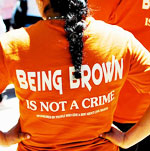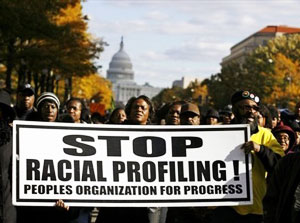
Blacks and Latinos make up 25.5 per cent and 28.6 per cent of NYC’s population respectively, yet account for about 85 per cent of all persons stopped by police.

FRONT PAGE
Site Search
About us
  

New York's Borough presidents
US mayors caught up in nation's culture war
The guns of America
US sanctuary cities
USA racial profiling
Rehabilitation of ex-felons in the US
Voting rights in the USA
US mayors fight against guns
US gun contol in tatters
US debates use of marijuana
Vision for metro America
Non-profits vital to urban USA
Nonprofits versus US cities
Catholic Church in urban USA
Funding cities
US poverty 2011
US affordable housing crisis
Black American men
Poverty in US cities
US school reforms
US urban inequality
US clergy and local politics

Worldwide | Elections | North America | Latin America | Europe | Asia | Africa |



























|
|
Racial profiling again under
scrutiny in the United States
By Tony Favro, USA Editor*
5 April 2013: A federal court in New York City is considering the legality of the New York Police Department’s ‘stop and frisk’ practices. The NYPD maintains that stopping and searching suspicious persons has resulted in the confiscation of illegal weapons and drugs, thus preventing crimes and saving lives. The plaintiffs in the court case argue that Blacks and Latinos are illegally characterized, or ‘profiled’, as troublemakers and stopped and frisked at higher rates than whites. Moreover, they say, there is no constitutional justification for the majority of the stops - that most people stopped aren’t “suspicious” in any meaningful, objective way - and that there is no oversight of the police department’s practice.
Racial profiling
Crime prevention policies in the US historically used the disproportionate application of laws to harass marginalized groups. At the turn of the 20th century, for example, selective enforcement of vagrancy and loitering laws focused on the homeless, unemployed, and poor. The US Supreme Court ruled in 1968 that police must have ‘reasonable suspicion’ of illegal activity before they can forcibly stop a person. Police must also have indications that a person possesses a weapon before they can search that individual. In other words, behavior must be the basis for detaining a person, not personal characteristics. In 1987, at a time of high and rising national crime rates, the Supreme Court ruled that even large racial disparities in the enforcement of laws, including the use of stop-and-frisk, are not a violation of civil rights.
New York City began its stop-and-frisk practices in 1990. Crime was skyrocketing and the NYPD made effective crime detection and prevention a priority. The NYPD combined high-tech data analysis of crime patterns and criminal behavior with low-tech stop-and-frisk. Crime dropped in New York City, and police departments across the US adopted the NYPD’s tactics. Crime began to decrease throughout the US, but complaints of racial profiling increased. Studies found that the drop in crime was due to many factors, such as an aging population, more jobs, and more police on the streets, but failed to find a correlation between lower crime rates and stop-and-frisk. Moreover, studies determined that the phenomena of ‘driving while black’ or ‘walking while brown’ were real, and that people of color were receiving undue scrutiny from police. By 2001, Congress appeared poised to ban racial profiling - then the 9/11 terrorist attacks occurred, and the racial profiling debate was overwhelmed by fears over homeland security and, later, undocumented foreign immigration.
 Blacks and Latinos are considerably Blacks and Latinos are considerably
more likely to be searched than Whites
Blacks and Latinos make up 25.5 per cent and 28.6 per cent of New York City’s population respectively, yet account for about 85 per cent of all persons stopped by police. Studies in New York and other major American cities show that frisked blacks are 42 per cent less likely than frisked whites to be carrying a weapon and 24 per cent less likely to possess drugs. Latinos stopped and searched by police are 32 per cent less likely than whites to be carrying a weapon and 34 per cent less likely to possess drugs.
In the name of homeland security, many individuals from predominantly Muslim nations must register with the US federal government, the clear assumption being that Arabs and Muslims are more likely than other groups to commit terrorist acts against the United States. The Transportation Security Administration, responsible for screening all airline passengers and baggage in the US, has been unable to prove that its Behavior Detection Program has lead to the apprehension of a single would-be terrorist, despite repeated accusations that individuals are unfairly profiled based on their appearance.
A 2002 decision by the Department of Justice said that states and local governments have the right to enforce federal immigration laws. Individuals suspected of being undocumented immigrants could be stopped and detained by state and local. While many local police departments decided not to go out of their way to apprehend suspected undocumented aliens, Latinos were targeted in many states and communities, and many US citizens reported being stopped and by local police and forced to show identification.
Gun ownership is seen as less suspicious than
wearing baggy trousers or carrying a Koran
Ironically, the murder of mostly white school children in the mostly white, affluent suburb of Newton, Connecticut helped rekindle the national debate on racial profiling. The shooter was a white male. In fact, 44 of the 62 mass shootings in the US since 1982 were committed by white males. Their average age at the time of the shootings was about 35. Several had expressed anger towards their female partners or co-workers, and several were racists. Yet, ‘angry white male’ does not arouse the suspicion of police or security personnel to the same degree as being a minority.
Most glaringly, gun ownership does not trigger the same level of suspicion as wearing baggy pants or carrying a Koran. Many of the mass shooters served in the military where they became familiar with automatic weapons. More that three quarters of the 143 guns used in the 62 US mass shootings since 1982 were purchased legally.
It’s not a coincidence that movements to end racial profiling and movements to limit automatic weapon sales are heating up simultaneously in the United States. Statistics show that whites are two and a half time more likely to own guns than Blacks or Latinos. More than three times as many men own guns as women. Abused women are more than five times likely to be killed by their abuser if he owns a gun, and in two-thirds of households containing a gun, one partner has threatened to use it against the other. In other words, guns reinforce existing power relationships. And gun ownership is a more dependable marker of potential violent behavior than race, ethnicity, dress, place or origin, citizenship, or religion.
The Newton shootings and the court case against stop-and-frisk in New York City highlight American society’s tolerance for unreliable characteristics for racial profiling as well as the persuasive power of political factions that refuse to acknowledge the risks to society from individual gun ownership. Americans, however, are becoming more aware of the contradictions. Recent Gallup polls show that a majority of Americans favor stricter gun laws and consider racial profiling unjust.
Civil Rights
Criminal profiling is a necessary part of law enforcement. A person with bomb making literature should be detained; a person with religious headwear probably should not. A person with violent-street-gang tattoos might reasonably invite heightened police attention, while a person in a hooded sweatshirt might not. Police must often try to guess intent and make decisions in ambiguous situations. But credible indicators of violence do exist. By incorporating proven predictors of violent behavior into their law enforcement tactics, such as gun ownership, and deemphasizing questionable markers, such as skin color, police can ensure both public safety and fundamental constitutional rights.
Selected resources:
• Mother Jones, America Under the Gun: A Special Report on Gun Laws and the Rise of Mass Shootings, www.motherjones.com/special-reports/2012/12/guns-in-america-mass-shootings.
• Gallup Poll, Men, Married, Southerners Most Likely to Be Gun Owners, February 2013.
• Leadership Conference on Civil and Human Rights, Restoring a National Consensus: The Need to End Racial Profiling, March 2011.
• CBS News, With TSA Under Fire, Is Racial Profiling on the Table? November 23, 2010.
• Legal Community Against Violence, Regulating Guns in America: An Evaluation and Comparative Analysis of Federal, State and Selected Local Gun Laws, February 2008.
*Tony Favro’s latest book Hard Constants: Sustainability and the American City is now available free of charge from City Mayors. Please complete our order form to receive a pdf copy. Libraries of academic institutions may receive a hard copy. Order form
Tony Favro also maintains the blog Planning and Investing in Cities.
|
|

|




































 Blacks and Latinos are considerably
Blacks and Latinos are considerably